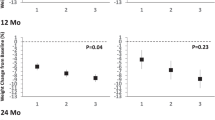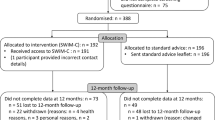Abstract
This study investigated the effect of post-treatment phone contact on weight-loss maintenance and activity behaviour in obese youngsters. In all, 20 patients who completed a weight reduction program were randomly assigned to a 5-month maintenance programme (experimental) or control condition. Following the maintenance programme, patients sent a weekly activity diary to the therapist, who in turn phoned them biweekly to discuss their activities. Body weight, stature and physical activity were measured before and after the maintenance programme. The control group showed a continuous increase in overweight after initial treatment, while the experimental group showed a steep increase during the summer holidays (no intervention), but this increase slowed down during the maintenance programme (P<0.05). Moderate-to-high intensity activities increased during the maintenance programme in the experimental group, but decreased in the control group (P<0.001). In conclusion, post-treatment phone contact appears to have the potential to be an effective maintenance strategy in obese youngsters.
This is a preview of subscription content, access via your institution
Access options
Subscribe to this journal
Receive 12 print issues and online access
$259.00 per year
only $21.58 per issue
Buy this article
- Purchase on Springer Link
- Instant access to full article PDF
Prices may be subject to local taxes which are calculated during checkout


Similar content being viewed by others
References
Deforche B, De Bourdeaudhuij I, Tanghe A, Hills, AP, De Bode P . Changes in physical activity and psychosocial determinants of physical activity in children and adolescents treated for obesity. Patient Educ Couns 2004; 55: 407–415.
Anderson JW, Konz EC, Frederich RC, Wood CL . Long-term weight-loss maintenance: a meta-analysis of US studies. Am J Clin Nutr 2001; 74: 579–584.
Perri MG, Shapiro RM, Ludwig WW, Twentyman CT, McAdoo WG . Maintenance strategies for the treatment of obesity: an evaluation of relapse prevention training and posttreatment contact by mail and telephone. J Consult Clin Psychol 1984; 52: 404–413.
Perri MG, McAdoo WG, McAllister DA, Lauer JB, Yancey DZ . Enhancing the efficacy of behavior therapy for obesity: effects of aerobic exercise and multicomponent maintenance program. J Consult Clin Psychol 1986; 54: 670–675.
Baum JG, Clark HB, Sandler J . Preventing relapse in obesity through posttreatment maintenance systems: comparing the relative efficacy of two levels of therapist support. J Behav Med 1991; 3: 287–302.
Perri MG, Sears SF, Clark JE . Strategies for improving maintenance of weight loss. Toward a continuous care model of obesity management. Diabetes Care 1993; 16: 200–209.
Braet C, Van Winckel M, Tanghe A, De Bode P, Franckx H . Inpatient treatment of obese children: a multicomponent program without stingent calorie restriction. Eur J Pediatr 2003; 162: 391–396.
Deforche B, De Bourdeaudhuij I, Debode P, Vinaimmont F, Hills AP, Verstraete S, Bouckaert J . Changes in fat mass, fat free mass and aerobic fitness in severely obese children and adolescents following a residential treatment programme. Eur J Pediatr 2003; 162: 616–622.
Mustajoki P, Pekkarinen T . Maintenance programmes after weight reduction – how useful are they? Int J Obes Rel Metab Disord 1999; 23: 553–555.
Aelvoet W, Foruin M, Hooft P, Vanoverloop J . May we use height and weight measured in school children and adolescents aged 3–19 years as reference data? Registration data from the Centre for School Health Care, 1996–1997. (Kunnen de lengte en het gewicht gemeten bij schoolgaande kinderen en adolescenten van 3 tot 19 jaar, gebruikt worden voor het aanmaken van referentiewaarden? Registratiegegevens van het Medisch Schooltoezicht (MST), 1996–1997.). In: Ministerie van de Vlaamse Gemeenschap, Adm. Gezondheidszorg, Entiteit beleidsondersteuning 2000 Gezondheidsindicatoren 1998. Ministerie Van de Vlaamse Gemeenschap: Brussel; 2000. pp 64–81.
Poskitt EME . Defining childhood obesity: the relative body mass index (BMI). Acta Paediatr 1995; 84: 961–963.
Montoye HJ, Kemper HCG, Saris WHM, Washburn RA (eds) Measuring Physical Activity and Energy Expenditure. Human Kinetics: Champaign, IL; 1996.
Taylor HL, Jacobs DR, Schucker B, Knudsen J, Leon ASL, Debacker G . A questionnaire for the assessment of leisure time physical activities. J Chronic Dis 1978; 31: 741–755.
Aaron DJ, Kriska AM, Dearwater SR, Cauley JA, Metz KF, LaPorte RE . Reproducibility and validity of an epidemiologic questionnaire to assess last year physical activity in adolescents. Am J Epidemiol 1995; 142: 191–201.
LaPorte RE, Cauley JA, Kinsey CM, Corbett W, Robertson R, black-Sandler R, Kuller LH, Falkel J . The epidemiology of physical activity in children, college students, middle-aged men, menopausal females and monkeys. J Chronic Dis 1982; 35: 787–795.
Albanes D, Conway JM, Taylor PR, Moe PW, Judd J . Validation and comparison of eight physical activity questionnqires. Epidemiology 1990; 1: 65–71.
Richardson MT, Leon AS, Jacobs DR, Ainsworth BE, Serfass R . Comprehensive evaluation of the Minnesota Leisure Time Physical Activity Questionnaire. J Clin Epidemiol 1994; 47: 271–281.
Hunter GR, Weinsier RL, Bamman MM, Larson DE . A role for high intensity exercise on energy balance and weight control. Int J Obes Relat Metab Disord 1998; 22: 489–493.
Jakicic JM . The role of physical activity in prevention and treatment of body weight gain in adults. J Nutr 2002; 132: 3826S–3829S.
Perri MG, Nezu AM, Viegener BJ . Improving the Long-Term Management of Obesity: Theory, Research and Clinical Guidelines. John Wiley & Sons: New York; 1992.
Acknowledgements
We are grateful to Dr Franckx for supporting this study and to Mieke De Roo and Anneleen Vindevogel for their assistance in collecting the data.
Author information
Authors and Affiliations
Corresponding author
Rights and permissions
About this article
Cite this article
Deforche, B., De Bourdeaudhuij, I., Tanghe, A. et al. Post-treatment phone contact: a weight maintenance strategy in obese youngsters. Int J Obes 29, 543–546 (2005). https://doi.org/10.1038/sj.ijo.0802924
Received:
Revised:
Accepted:
Published:
Issue Date:
DOI: https://doi.org/10.1038/sj.ijo.0802924



